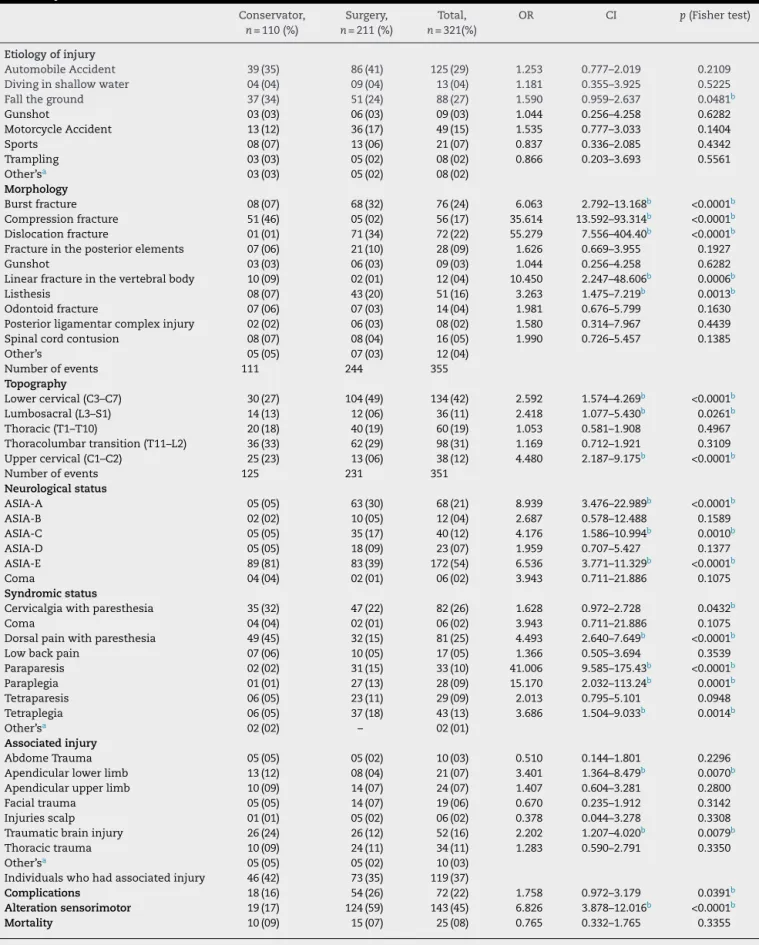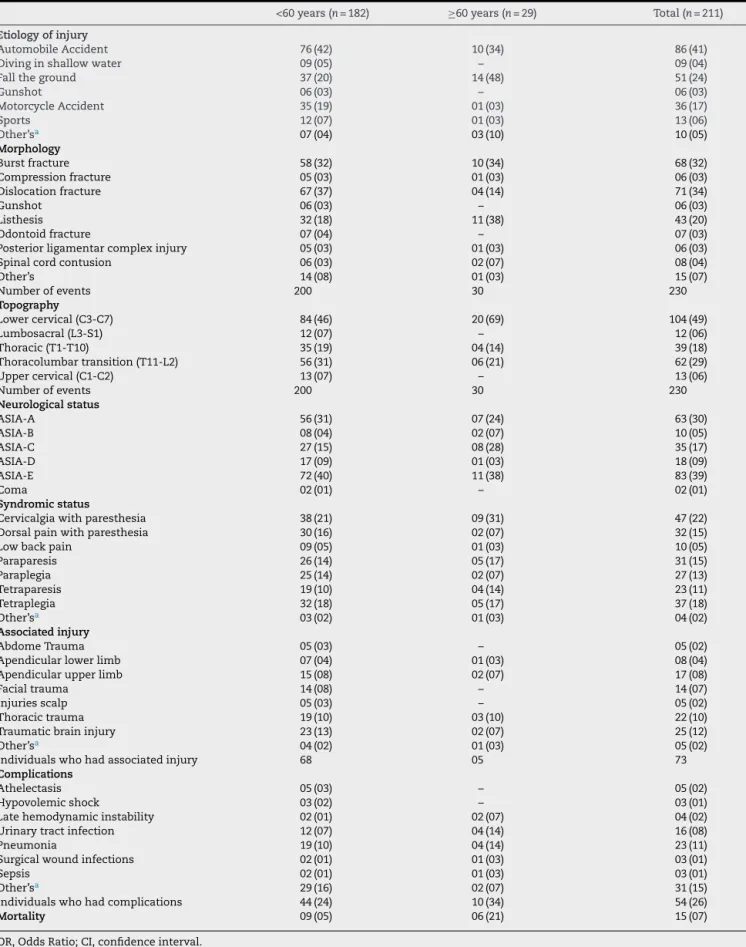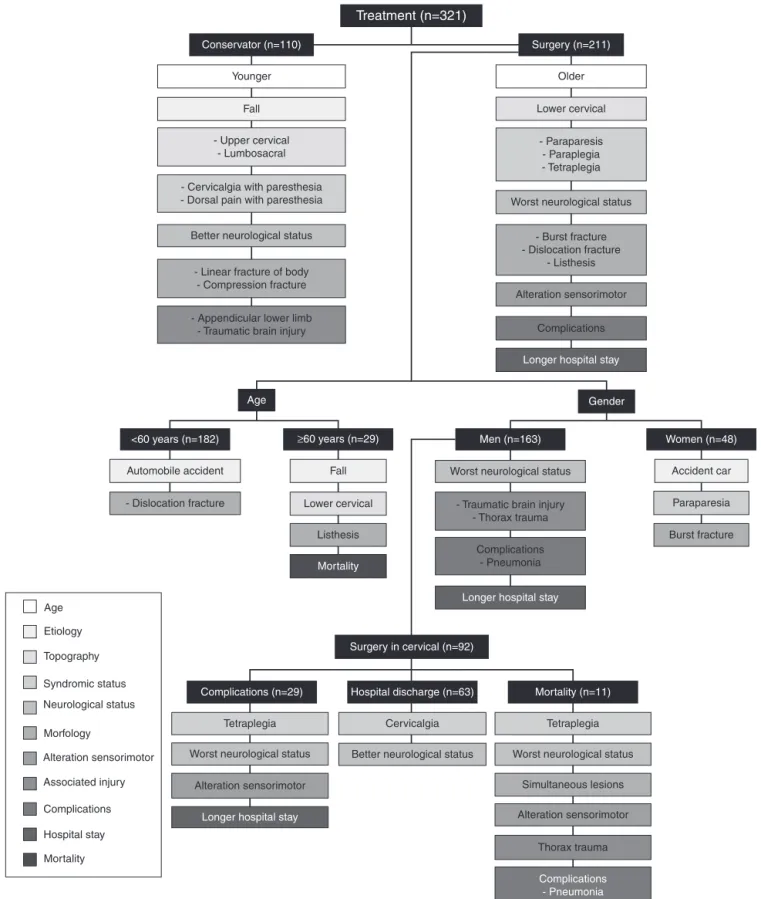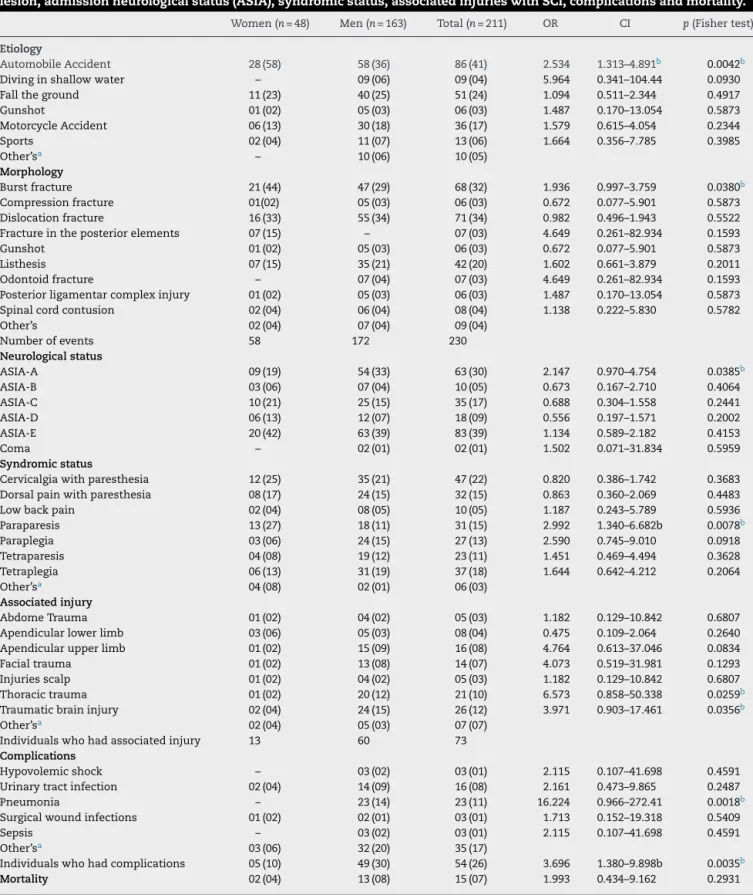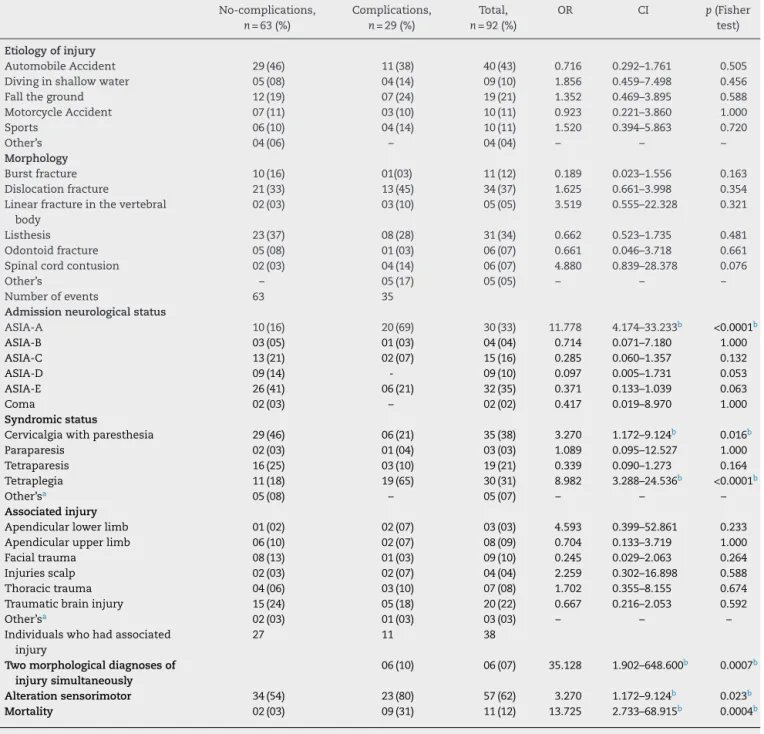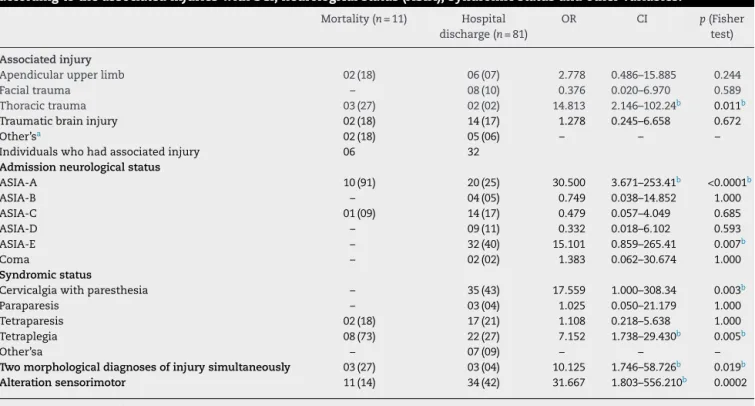SOCIEDADE BRASILEIRA DE ORTOPEDIA E TRAUMATOLOGIA
w w w . r b o . o r g . b r
Original
article
Characteristics
and
clinical
aspects
of
patients
with
spinal
cord
injury
undergoing
surgery
夽
João
Simão
de
Melo-Neto
a,b,c,∗,
Lara
Eduarda
Leite
Vidotto
b,
Fabiana
de
Campos
Gomes
d,
Dionei
Freitas
de
Morais
c,
Waldir
Antonio
Tognola
c aFaculdadeCeres(FACERES),DepartamentoMorfofuncional,SãoJosédoRioPreto,SP,BrazilbInstitutoMunicipaldeEnsinoSuperiordeCatanduva(IMES),Catanduva,SP,Brazil
cFaculdadedeMedicinadeSãoJosédoRioPreto(FAMERP),DepartamentodeNeurociências,SãoJosédoRioPreto,SP,Brazil
dFaculdadedeMedicinadeSãoJosédoRioPreto(FAMERP),UnidadedePesquisaemGenéticaeBiologiaMolecular,SãoJosédoRioPreto,
SP,Brazil
a
r
t
i
c
l
e
i
n
f
o
Articlehistory:
Received26April2016 Accepted28July2016
Availableonline29December2016
Keywords:
Epidemiology Spinalcordinjuries Spinalfusion Spinalfractures Mortality Traumatology
a
b
s
t
r
a
c
t
Objective:Toidentifythecharacteristicsofpatientswithspinalcordinjury(SCI)undergoing surgery.
Methods:Previously,321patientswithSCIwereselected.Clinicalandsocio-demographic variableswerecollected.
Results:Atotalof211patientsweresubmittedtosurgery.Fallandinjuriesintheupper cer-vicalandlumbosacralregionswereassociatedwithconservativetreatment.Patientswith lesionsinthelowercervicalspine,worseneurologicalstatus,andunstableinjurieswere associatedwithsurgery.Individuals undergoingsurgerywereassociatedwith complica-tionsaftertreatment.Theauthorsassessedwhetherageinfluencedthecharacteristicsof patientssubmittedtosurgery.Subjectswith<60yearsofagewereassociatedwith motorcy-cleaccidentsandthemorphologiesofinjurywerefracture-dislocation.Elderlyindividuals wereassociatedtofall,SCIinthelowercervicalspineandthemorphologyofinjurywas listhesis.Subsequently,theauthorsanalyzedthegendercharacteristicsinthesepatients. Womenwhosufferedcaraccidentswereassociatedtosurgery.Womenwereassociatedwith paraparesisandthemorphologicdiagnosiswasfracture-explosion,especiallyinthe tho-racolumbartransitionandlumbosacralregions.Menwhopresentedtraumaticbraininjury andthoracictraumawererelatedtosurgery.Theseindividualshadaworseneurological sta-tusandwereassociatedtocomplications.Menandthecervicalregionweremostaffected, thereby,thesesubjectswereanalyzedseparately(n=92).Thepresenceofcomplications increasedthelengthofhospitalstay.Thesimultaneouspresenceofmorphological diagno-sis,worstneurologicalstatus,tetraplegia,sensory,andmotoralterationswereassociated withcomplications.Pneumoniaandchesttraumawereassociatedwithmortality.
Conclusion: Thesefactorsenableinvestmentsinprevention,rehabilitation,andtreatment. ©2016SociedadeBrasileiradeOrtopediaeTraumatologia.PublishedbyElsevierEditora
Ltda.ThisisanopenaccessarticleundertheCCBY-NC-NDlicense(http:// creativecommons.org/licenses/by-nc-nd/4.0/).
夽WorkdevelopedattheFaculdadedeMedicinadeSãoJosédoRioPreto(FAMERP),DepartamentodeNeurociências,SãoJosédoRio Preto,SP,Brasil.
∗ Correspondingauthor.
E-mail:joaosimao03@hotmail.com(J.S.Melo-Neto).
http://dx.doi.org/10.1016/j.rboe.2016.07.003
Caracterizac¸ão
e
aspectos
clínicos
de
pacientes
com
traumatismo
raquimedular
submetidos
à
cirurgia
Palavras-chave:
Epidemiologia
Traumatismosdamedula espinal
Fusãovertebral
Fraturasdacolunavertebral Mortalidade
Traumatologia
r
e
s
u
m
o
Objetivo: Identificarascaracterísticasdepacientescomtraumatismoraquimedular(TRM) submetidosàcirurgia.
Métodos: Previamente,321pacientescomTRMforamselecionados.Asvariáveisclínicase sócio-demográficasforamcoletadas.
Resultados: Umtotal de 211pacientes foramsubmetidos a cirurgia. A quedae lesões nas regiõescervical superiore lombosacral foram associadas com tratamento conser-vador.Pacientescomlesõesnasregiõescervicalinferior,piorstatusneurológicoelesões instáveis foram associados com cirurgia. Indivíduos operados foram associados com complicac¸õesapóstratamento.Posteriormente,osautoresavaliaramseidade influenci-avaascaracterísticasdospacientessubmetidosàcirurgia.Sujeitoscom<60anosforam associadoscomacidentemotociclísticoeodiagnósticodefratura-luxac¸ão. Subsequente-mente,analisaram-seascaracterísticasdossexosnestespacientes.Mulheresquesofreram acidenteautomobilísticoforamassociadascomcirurgia.Mulheresforamassociadascom paraparesiaediagnósticomorfológicodefraturaexplosão,principalmentenasregiõesde transic¸ãotóraco-lombarelombo-sacral.Homensqueapresentaramtraumatismo crânio-encefálicoetorácicoforamrelacionadosacirurgia.Estesindivíduostiveramumpiorstatus neurológicoeforamassociadosàcomplicac¸ão.Homenseregiãocervicalforammais afe-tadas; portanto,estespacientesforam analisadosisoladamente(n=92).A presenc¸a de complicac¸õesaumentouapermanênciahospitalar.Apresenc¸adediagnósticos morfológi-cossimultaneamente,piorstatusneurológico,tetraplegia,alterac¸ãosensório-motoraforam associadoscomcomplicac¸ões.Pneumoniaetraumatismotorácicoforamassociadoscom mortalidade.
Conclusão: Estesfatores possibilitaminvestimentosem prevenc¸ão,reabilitac¸ão e trata-mento.
©2016SociedadeBrasileiradeOrtopediaeTraumatologia.PublicadoporElsevier EditoraLtda.Este ´eumartigoOpenAccesssobumalicenc¸aCCBY-NC-ND(http:// creativecommons.org/licenses/by-nc-nd/4.0/).
Introduction
Thespinalcordinjury(SCI)referstovertebralcolumnlesions that may result in transient or irreversible consequences, dependingontheaffectedtissuesduringtrauma.1–3The
clin-icalcomplicationsafterSCIarebeingevaluated3–5toimprove
interventionsandachievebetterprognosisforthesepatients, reducingsocioeconomiccostsandmortality.However,there are few studies addressing the characteristics and clinical aspects of patients undergoing surgery. Only one descrip-tive study6 was found in Brazil, demonstrating the need
tobetterunderstand thispopulation and determinewhere investmentsshouldbemadeforpreventionandtreatment. Moreover,culturalfactorsandregionaldifferencesmustnot beneglected.7
There are numerous technical instrumentation and fix-ation methodsusedinpatients withtraumaticcordspinal injury.However,thetechniqueuseddependsonthepatient, characteristics of the lesion and on the surgeon’s experi-ence.In general, posterior instability should be treated by posteriorfusion and anterior instabilitybyanterior fusion. However,whenthereiscompletediscoligamentousinjury, cir-cularorcombinedfixationisrecommendedtogiveadequate stabilization.8
Surgicalinterventionpromotesdissectionandretractionof theseveralstructurestoexposureofspinetocorrecttheinjury installed,9possiblyresultinginothertissuelesions,and,asa
consequence,increasingtheclinicalcomplicationsand mor-tality.
Therefore,theobjectiveofthisstudyistoidentifythe char-acteristicsand clinical aspectsofpatientswithspinalcord injurysubmittedtosurgery.
Methodology
Prospective studyconductedatHospitalde Base,a tertiary referralcenter.StudyapprovedbytheResearchEthics Com-mittee,protocol806.452.
Three hundred and twenty-one patients with SCI were selectedfrom2008to2012.Aninitialevaluationwasmadeto confirmthediagnosisofSCI.Patientsweresubmittedto radio-logicalanalysisusingcomputedtomographyand/ormagnetic resonanceimaging.2
Patientswithinjuryintheuppercervicalregion(C1–C2), lowercervical(C3–C7),thoracic(T1–T10),thoracolumbar tran-sition (T11–L2) and lumbosacral (L3–S1) were included in the study.3 Morphologicalclassificationoflesions was
per-formedassuggestedbyDenis.10 Theneurologicalstatusof
patients was obtainedbythe ASIAscale (American Spinal InjuryAssociation).11Clinicalcomplicationspresentedwithin
30daysofhospitalizationwerecollected.3
Initially, the variables frequently presented by patients undergoing surgery were reported. We then evaluated the factors most associated with surgery when compared to conservativetreatment,age,genderandmorbidity/mortality in men submitted to surgical treatment in the cervical spine.
Data analysis was performed using descriptive and inferential statistics. Descriptive resultswere expressed as mean±standarddeviation(parametricdistribution),median withminimum,maximum(non-parametricdistribution),and absoluteandrelativefrequencies.Theanalysisofthe normal-ityofthedatawasperformedusingtheKolmogorov–Smirnov test. Data with parametric distribution were analyzed by unpairedt test, and the nonparametric forMann–Whitney test.TheassociationbetweenvariableswasassessedforOdds Ratio(OR)withaconfidenceinterval(CI),beingconfirmedby theFisherexacttest.Ap≤0.05valuewasconsidered statis-ticallysignificant. Statistical analysiswas performed using Instatsoftware (version3.0,GraphPad, Inc.,San Diego,CA, USA).
Results
IndividualswithSCIwhoweresubmittedtosurgery(n=211) werefromtheprivatehealthcareservice(18%)andfromthe public healthcare system (82%). Patients from 65 different citiesexamined.Withregardtoethnicity:85%wereCaucasian, 8%mulatto,4%Black,3%unidentified.Thelevel of educa-tionwasclassifiedasilliterate(4%),primaryeducation(59%), secondaryeducation(26%)andhighereducation(11%).The mostfrequentmaritalstatus wassingle (47%),followed by married(38%), widowed(8%) and divorced (4%), and seven individualsnotreported.Theoccupationofpatientswas dis-tributedtoemployees(83%),homeworker(7%),unemployed (5%),students(4%)andretired(1%).Religionwasdistributedas RomanCatholic(76%),EvangelicalProtestant(10%),Orthodox Catholic(5%),agnostic(5%)andothers(4%).
Inaddition,weobservedthatthesepatientsaremainly: male (77%); admitted after suffering a car accident (41%); associatedlesion:traumaticbraininjury(12%);thelower cer-vicalspineisthemostaffectedregion(49%);cervicalgiawith paresthesia(22%);morphologicaldiagnosisoffracture dislo-cation(34%); andneurologicalstatusASIA-E(39%).Surgical interventionsweredistributedasanterior(51%)andposterior (46%)arthrodesis,decompressivelaminectomy(4%)and cor-pectomy(9%).Ofthesepatients,10%requiredmorethanone surgicalproceduresimultaneously.
Thefactorsmostassociatedwithsurgerywhencompared toconservative treatmentsuchasage,genderand morbid-ity/mortality in men undergoing surgical treatment in the cervicalareaareshowninFig.1.
Surgicalorconservativetreatment
Patientswereinitiallyanalyzedtoverifywhatwerethe crite-riamostassociatedtotreatmentoptions,surgical(n=211)or conservative(n=110).Thecharacterizationandpredictive fac-torsareshowninTable1.Meanageofpatientsundergoing surgery[44.5(11–93)years]wassignificantlyhigher(p=0.0004, Mann–Whitney test)than those without surgery[36 (5–89) years].OfallSCIetiologies,fallingwasassociatedwith con-servativetreatment.
Thirty-five individuals had lesions in two regions con-comitantly. Individuals who had SCI inthe upper cervical andlumbosacralregionswerereferredmainlytoconservative treatment,whereaspatientswithlesionsinthelower cervi-calregionweremoreassociatedwithsurgery.Inthiscontext, thesyndromicstatusmoreassociatedwithconservative treat-ment was neckand dorsal painwith paresthesia,whereas paraparesis,paraplegia andquadriplegiaweremorerelated tosurgery.Patientswithbetterneurologicalstatusweremore associatedwithconservativetreatment,whereasthosewith worse neurological status were more related with surgery. Patientswithsensorimotoralterationswereseventimesmore inoperatedpatients.
Regardingtheassociatedinjuries,therewere180events, and 31 patients had twolesions,and 15 had three lesions simultaneously.Patientsadmittedwithassociatedlesionsin thelowerlimbsandtraumaticbraininjuryweresignificantly morereferredtoconservativetreatment.
Morphological diagnosis oflesions obtained byimaging exame showed that patients with linear fracture of the vertebral body and compression fracture were referred to conservative treatment. However,patients with burst frac-ture, dislocation fracture and listhesis were referred to surgery. Thirty-two individuals had two morphologic diag-noses, whereas three of them had three simultaneous lesions.
Operated individuals were significantly moreassociated with complications after SCI. There were 86 complication eventsin54patientsundergoingsurgery,ofwhich13hadtwo complications,andsevenhadthreecomplications.The com-plicationsmostincidentsinindividualssubmittedtosurgery werepneumonia(11%)andurinarytractinfection(8%), how-ever,therewasnodifferenceamongthenon-surgicalpatients. Afteradmission,hospitalstaywassignificantlylongerin individuals undergoingsurgery [7 (1–127)days]when com-paredtothosewithconservativetreatment[3(1–112)days]. Othervariableswerenotsignificantlydifferent.
Surgicaltreatmentaccordingtoage
Wethenevaluatedifthevariableage,<60years(5–59years,
n=182)or≥60years(60–89years,n=29),playedaroleinthe characteristics ofpatientsundergoingsurgery, accordingto
Table2.Subjects<60yearsofageweremoreassociatedwith motorcycleaccidents(p=0.023,Fishertest),whereaselderly individualsweretwiceasmuchassociatedwithfall(OR:1.622, CI:1.622–8.248,p=0.002,Fishertest).
Table1–Distributionofindividuals(conservativetreatmentandsurgery)accordingtoetiology,topography,morphology ofthelesion,neurologicalstatusatadmission(ASIA),syndromicstatus,injuriesassociatedwithSCI,complications, mortalityandothervariables.
Conservator,
n=110(%)
Surgery,
n=211(%)
Total,
n=321(%)
OR CI p(Fishertest)
Etiologyofinjury
AutomobileAccident 39(35) 86(41) 125(29) 1.253 0.777–2.019 0.2109
Divinginshallowwater 04(04) 09(04) 13(04) 1.181 0.355–3.925 0.5225
Falltheground 37(34) 51(24) 88(27) 1.590 0.959–2.637 0.0481b
Gunshot 03(03) 06(03) 09(03) 1.044 0.256–4.258 0.6282
MotorcycleAccident 13(12) 36(17) 49(15) 1.535 0.777–3.033 0.1404
Sports 08(07) 13(06) 21(07) 0.837 0.336–2.085 0.4342
Trampling 03(03) 05(02) 08(02) 0.866 0.203–3.693 0.5561
Other’sa 03(03) 05(02) 08(02)
Morphology
Burstfracture 08(07) 68(32) 76(24) 6.063 2.792–13.168b <0.0001b
Compressionfracture 51(46) 05(02) 56(17) 35.614 13.592–93.314b <0.0001b
Dislocationfracture 01(01) 71(34) 72(22) 55.279 7.556–404.40b <0.0001b
Fractureintheposteriorelements 07(06) 21(10) 28(09) 1.626 0.669–3.955 0.1927
Gunshot 03(03) 06(03) 09(03) 1.044 0.256–4.258 0.6282
Linearfractureinthevertebralbody 10(09) 02(01) 12(04) 10.450 2.247–48.606b 0.0006b
Listhesis 08(07) 43(20) 51(16) 3.263 1.475–7.219b 0.0013b
Odontoidfracture 07(06) 07(03) 14(04) 1.981 0.676–5.799 0.1630
Posteriorligamentarcomplexinjury 02(02) 06(03) 08(02) 1.580 0.314–7.967 0.4439
Spinalcordcontusion 08(07) 08(04) 16(05) 1.990 0.726–5.457 0.1385
Other’s 05(05) 07(03) 12(04)
Numberofevents 111 244 355
Topography
Lowercervical(C3–C7) 30(27) 104(49) 134(42) 2.592 1.574–4.269b <0.0001b
Lumbosacral(L3–S1) 14(13) 12(06) 36(11) 2.418 1.077–5.430b 0.0261b
Thoracic(T1–T10) 20(18) 40(19) 60(19) 1.053 0.581–1.908 0.4967
Thoracolumbartransition(T11–L2) 36(33) 62(29) 98(31) 1.169 0.712–1.921 0.3109
Uppercervical(C1–C2) 25(23) 13(06) 38(12) 4.480 2.187–9.175b <0.0001b
Numberofevents 125 231 351
Neurologicalstatus
ASIA-A 05(05) 63(30) 68(21) 8.939 3.476–22.989b <0.0001b
ASIA-B 02(02) 10(05) 12(04) 2.687 0.578–12.488 0.1589
ASIA-C 05(05) 35(17) 40(12) 4.176 1.586–10.994b 0.0010b
ASIA-D 05(05) 18(09) 23(07) 1.959 0.707–5.427 0.1377
ASIA-E 89(81) 83(39) 172(54) 6.536 3.771–11.329b <0.0001b
Coma 04(04) 02(01) 06(02) 3.943 0.711–21.886 0.1075
Syndromicstatus
Cervicalgiawithparesthesia 35(32) 47(22) 82(26) 1.628 0.972–2.728 0.0432b
Coma 04(04) 02(01) 06(02) 3.943 0.711–21.886 0.1075
Dorsalpainwithparesthesia 49(45) 32(15) 81(25) 4.493 2.640–7.649b <0.0001b
Lowbackpain 07(06) 10(05) 17(05) 1.366 0.505–3.694 0.3539
Paraparesis 02(02) 31(15) 33(10) 41.006 9.585–175.43b <0.0001b
Paraplegia 01(01) 27(13) 28(09) 15.170 2.032–113.24b 0.0001b
Tetraparesis 06(05) 23(11) 29(09) 2.013 0.795–5.101 0.0948
Tetraplegia 06(05) 37(18) 43(13) 3.686 1.504–9.033b 0.0014b
Other’sa 02(02) – 02(01)
Associatedinjury
AbdomeTrauma 05(05) 05(02) 10(03) 0.510 0.144–1.801 0.2296
Apendicularlowerlimb 13(12) 08(04) 21(07) 3.401 1.364–8.479b 0.0070b
Apendicularupperlimb 10(09) 14(07) 24(07) 1.407 0.604–3.281 0.2800
Facialtrauma 05(05) 14(07) 19(06) 0.670 0.235–1.912 0.3142
Injuriesscalp 01(01) 05(02) 06(02) 0.378 0.044–3.278 0.3308
Traumaticbraininjury 26(24) 26(12) 52(16) 2.202 1.207–4.020b 0.0079b
Thoracictrauma 10(09) 24(11) 34(11) 1.283 0.590–2.791 0.3350
Other’sa 05(05) 05(02) 10(03)
Individualswhohadassociatedinjury 46(42) 73(35) 119(37)
Complications 18(16) 54(26) 72(22) 1.758 0.972–3.179 0.0391b
Alterationsensorimotor 19(17) 124(59) 143(45) 6.826 3.878–12.016b <0.0001b
Mortality 10(09) 15(07) 25(08) 0.765 0.332–1.765 0.3355
OR,OddsRatio;CI,confidenceinterval. a Lessthanthreeindividualsineachcategory.
Table2–Distributionofindividuals(<60and≥60years)withsurgicaltreatment,accordingtotheetiology,topography, morphologyoflesion,admissionneurologicalstatus(ASIA),syndromicstatus,associatedinjurieswithSCI,
complicationsandmortality.
<60years(n=182) ≥60years(n=29) Total(n=211)
Etiologyofinjury
AutomobileAccident 76(42) 10(34) 86(41)
Divinginshallowwater 09(05) – 09(04)
Falltheground 37(20) 14(48) 51(24)
Gunshot 06(03) – 06(03)
MotorcycleAccident 35(19) 01(03) 36(17)
Sports 12(07) 01(03) 13(06)
Other’sa 07(04) 03(10) 10(05)
Morphology
Burstfracture 58(32) 10(34) 68(32)
Compressionfracture 05(03) 01(03) 06(03)
Dislocationfracture 67(37) 04(14) 71(34)
Gunshot 06(03) – 06(03)
Listhesis 32(18) 11(38) 43(20)
Odontoidfracture 07(04) – 07(03)
Posteriorligamentarcomplexinjury 05(03) 01(03) 06(03)
Spinalcordcontusion 06(03) 02(07) 08(04)
Other’s 14(08) 01(03) 15(07)
Numberofevents 200 30 230
Topography
Lowercervical(C3-C7) 84(46) 20(69) 104(49)
Lumbosacral(L3-S1) 12(07) – 12(06)
Thoracic(T1-T10) 35(19) 04(14) 39(18)
Thoracolumbartransition(T11-L2) 56(31) 06(21) 62(29)
Uppercervical(C1-C2) 13(07) – 13(06)
Numberofevents 200 30 230
Neurologicalstatus
ASIA-A 56(31) 07(24) 63(30)
ASIA-B 08(04) 02(07) 10(05)
ASIA-C 27(15) 08(28) 35(17)
ASIA-D 17(09) 01(03) 18(09)
ASIA-E 72(40) 11(38) 83(39)
Coma 02(01) – 02(01)
Syndromicstatus
Cervicalgiawithparesthesia 38(21) 09(31) 47(22)
Dorsalpainwithparesthesia 30(16) 02(07) 32(15)
Lowbackpain 09(05) 01(03) 10(05)
Paraparesis 26(14) 05(17) 31(15)
Paraplegia 25(14) 02(07) 27(13)
Tetraparesis 19(10) 04(14) 23(11)
Tetraplegia 32(18) 05(17) 37(18)
Other’sa 03(02) 01(03) 04(02)
Associatedinjury
AbdomeTrauma 05(03) – 05(02)
Apendicularlowerlimb 07(04) 01(03) 08(04)
Apendicularupperlimb 15(08) 02(07) 17(08)
Facialtrauma 14(08) – 14(07)
Injuriesscalp 05(03) – 05(02)
Thoracictrauma 19(10) 03(10) 22(10)
Traumaticbraininjury 23(13) 02(07) 25(12)
Other’sa 04(02) 01(03) 05(02)
Individualswhohadassociatedinjury 68 05 73
Complications
Athelectasis 05(03) – 05(02)
Hypovolemicshock 03(02) – 03(01)
Latehemodynamicinstability 02(01) 02(07) 04(02)
Urinarytractinfection 12(07) 04(14) 16(08)
Pneumonia 19(10) 04(14) 23(11)
Surgicalwoundinfections 02(01) 01(03) 03(01)
Sepsis 02(01) 01(03) 03(01)
Other’sa 29(16) 02(07) 31(15)
Individualswhohadcomplications 44(24) 10(34) 54(26)
Mortality 09(05) 06(21) 15(07)
Treatment (n=321)
Conservator (n=110) Surgery (n=211)
Younger Older
Lower cervical
- Paraparesis - Paraplegia - Tetraplegia
Worst neurological status
- Burst fracture - Dislocation fracture
- Listhesis
Alteration sensorimotor
Complications
Longer hospital stay
Worst neurological status Fall
Lower cervical
Listhesis
Mortality Automobile accident
- Dislocation fracture - Traumatic brain injury - Thorax trauma
Complications - Pneumonia
Longer hospital stay
Tetraplegia Age
Etiology
Topography
Syndromic status
Neurological status
Morfology
Alteration sensorimotor
Associated injury
Complications
Hospital stay
Mortality
Worst neurological status
Alteration sensorimotor
Longer hospital stay
Cervicalgia Tetraplegia
Worst neurological status
Simultaneous lesions
Alteration sensorimotor
Thorax trauma
Complications - Pneumonia Better neurological status
Accident car
Paraparesia
Burst fracture
Gender
Men (n=163) Age
<60 years (n=182) ≥60 years (n=29)
Surgery in cervical (n=92)
Hospital discharge (n=63)
Complications (n=29) Mortality (n=11)
Women (n=48)
Fall
- Upper cervical - Lumbosacral
- Cervicalgia with paresthesia - Dorsal pain with paresthesia
Better neurological status
- Linear fracture of body - Compression fracture
- Appendicular lower limb - Traumatic brain injury
Fig.1–Factorsmostassociatedwithsurgerywhencomparedtoconservativetreatment,age,genderand morbidity/mortalityinmenundergoingsurgicaltreatmentinthecervicalspine.
topographyandthe morphologicdiagnosis,19patientshad twosimultaneous lesions.Themorphologiesofinjury, dis-locationfracture(OR:3.641,CI:1.215–10.916;p=0.010,Fisher test)andlisthesis(OR:2.865,CI:1.234–6.647,p=0.015,Fisher
test)weresignificantlymoreassociatedwithage<60yearsand ≥60years,respectively.
threecomplicationsatthe sametime. However,associated injuriesandcomplicationsdidnotdifferbetweenthedifferent agegroups(p>0.05).
Hospitalstaywassimilarbetweenthedifferentagegroups (p=0.071,Mann–Whitneytest).However,thenumberofdeaths was five times more associated with elderly patients (OR: 5.014,CI:1.634–15.386;p=0.008,Fishertest).Othervariables werenotsignificantlydifferent.
Surgicaltreatmentaccordingtogender
Subsequently,weanalyzedthecharacteristicsofbothgenders (♂n=163;♀n=48)inpatientsundergoingsurgery.The charac-terizationandpredictivefactorsareshowninTable3.Mean ageinoperatedwomen[37(6–84)years]wasnotsignificantly different(p=0.160,Mann–Whitneytest)thaninmen[36(5–89) years].Weobservedthatwomenwhosufferedcaraccidents werethreetimesmoresubjectedtosurgicalintervention.
Nineteenindividualshadtwomorphologicalsimultaneous diagnoses. Nineteen patients had two, and five had three lesionsassociatedwithSCI.Menwithtraumaticbraininjury and thoracic trauma were more related to surgery than women.
Twentyindividualspresentedlesionsintworegions con-comitantly.Thetopographyoflesionwasdividedintoupper (6%)andlowercervical(49%)spine,thorax(19%), thoracolum-bar(29%)andlumbosacral(6%)transition.Theaffectedregions didnotdifferbetweengenders.
When analyzing the symptoms, it was observed that women are three times more associatedwith paraparesis. Still,womenweremoreassociatedwiththemorphologic diag-nosisburstfracture,especiallyinthethoracolumbartransition andlower back(OR:18.4,IC:4.266–79.371;p<0.0001,Fisher test).
Menhaveaworseneurologicalstatusandhadthreetimes more complications than women, especially the presence ofpneumoniaaftersurgery.Twentypatientshadtwo com-plications,whereas sevenpatients had threesimultaneous complications.Thelengthofhospitalstayinmen[8(1–127 days]wassignificantlyhigherthaninwomen[5(1–34)days]. Othervariableswerenotsignificantlydifferent.
Morbidity/mortalityinmenundergoingsurgicaltreatment afterSCIinthecervicalspine
Asobservedpreviously,menandcervical regionwere most affectedandaremoresusceptibletocomplications,thereby, thesesubjectswereanalyzedseparately.Thecharacterization andpredictivefactorsareshowninTables4and5.
Ninety-twomen were analyzed.They were divided into a group without complications (n=63) and another group of patients who presented complications (n=29). Mean age (without complications=41±17 years; with complica-tions=46±20 years)was similar(p=0.162, unpairedt-test). Individuals with complications had longer hospital stay (p<0.0001,Mann–Whitneytest).ThemaincauseofSCIinboth groupswasmotorvehicleaccident,correspondingto43%of theindividuals(Table4).
Themain morphologiesof traumawere: fracture dislo-cation (37%) and listhesis (34%). Six individuals had two
morphologicallesionsassociatedtoSCI(Table4).The pres-enceoftwosimultaneousmorphologicaldiagnosesofinjury increasedtheassociationwithpostoperativecomplications. ThemostprevalenttopographyofinjurywasC6(n=58), fol-lowedbyC5(n=45),C7(n=27),C4(n=24),C3(n=12),C2(n=10) and C1 (n=1).Four patients had four injured vertebrae, 11 had injuriesinthreevertebrae,61 intwo,and16 hadonly aninjuredvertebra.Furthermore,tenpatientshadavertebral injuryinthethoracicspinesimultaneously.
ThemostcommonneurologicstatusaccordingtotheASIA scalewere“E”(35%),followedby“A”(33%).However, individ-ualswithoutcomplicationshadpredominantlyASIA-E(41%), whereasASIA-A(69%)wasmoreassociatedtocomplications (Table4).
The most prevalent syndromic state was tetraplegia (33%), followed by cervicalgia (29%). The tetraplegia was more associated with the development of complications after surgery. There were sensorimotor alterations in the groups (no-complication=34;complication=23). Individuals withcomplications werethree timesmoreassociatedwith sensorimotoralterationssubsequenttoSCI.Thirty-eightmen suffered injuries associated with the SCI (without compli-cations=27,withcomplications=11).TraumaticBrainInjury wasthemostcommoninthispopulation(without complica-tions=15,withcomplication=6),asshowninTable4.Thoracic trauma wasthe second mostfrequentassociatedinjuryin patients with complications (14%). However, only thoracic traumademonstratedanassociationwithmortality(Table5). Twosubjectssufferedthreeinjuries,14sufferedtwo,andthe others(n=32)onlyoneinjuryassociatedwiththeSCI.
Themostcommon complicationspresentedwere pneu-monia(66%),urinarytractinfection(31%),atelectasis(14%), hypovolemicshock(7%),latehemodynamicinstability(7%), sepsis(7%)andotherscomplicationsinonlyoneindividual per category (45%). Five subjects had three complications, 12 had two, and the others (n=12) had only one compli-cationafter the SCI.There were 11cases ofdeath,82% in the individuals with complications. Complicationswere 14 timesmoreassociatedwithmortality.Pneumoniawas asso-ciated with increasedmortality (OR:31.95, CI=6.02–169.64;
p<0.0001). Neurological status ASIA-A was 30 times more associatedwithmortalityand ASIA-Ewasmoreassociated withhospitaldischarge (Table5). Tetraplegia,sensorimotor alterationsandthepresenceoftwomorphologicalinjury diag-nosesweremoreassociatedwithmortality.Cervicalgiawas moreassociatedwithhospitaldischarge(Table5).
Discussion
Aimingatidentifyingthecharacteristicsandclinicalaspects of patientswith spinal cordinjury undergoingsurgery, we analyzed the variables mostassociatedwith surgerywhen comparedtoconservativetreatment,age,genderand morbid-ity/mortalityinmensubmittedtosurgicaltreatmentinthe cervical.
Table3–Distributionofindividuals(menandwomen)withsurgicaltreatment,accordingtotheetiology,morphologyof lesion,admissionneurologicalstatus(ASIA),syndromicstatus,associatedinjurieswithSCI,complicationsandmortality.
Women(n=48) Men(n=163) Total(n=211) OR CI p(Fishertest)
Etiology
AutomobileAccident 28(58) 58(36) 86(41) 2.534 1.313–4.891b 0.0042b
Divinginshallowwater – 09(06) 09(04) 5.964 0.341–104.44 0.0930
Falltheground 11(23) 40(25) 51(24) 1.094 0.511–2.344 0.4917
Gunshot 01(02) 05(03) 06(03) 1.487 0.170–13.054 0.5873
MotorcycleAccident 06(13) 30(18) 36(17) 1.579 0.615–4.054 0.2344
Sports 02(04) 11(07) 13(06) 1.664 0.356–7.785 0.3985
Other’sa – 10(06) 10(05)
Morphology
Burstfracture 21(44) 47(29) 68(32) 1.936 0.997–3.759 0.0380b
Compressionfracture 01(02) 05(03) 06(03) 0.672 0.077–5.901 0.5873
Dislocationfracture 16(33) 55(34) 71(34) 0.982 0.496–1.943 0.5522
Fractureintheposteriorelements 07(15) – 07(03) 4.649 0.261–82.934 0.1593
Gunshot 01(02) 05(03) 06(03) 0.672 0.077–5.901 0.5873
Listhesis 07(15) 35(21) 42(20) 1.602 0.661–3.879 0.2011
Odontoidfracture – 07(04) 07(03) 4.649 0.261–82.934 0.1593
Posteriorligamentarcomplexinjury 01(02) 05(03) 06(03) 1.487 0.170–13.054 0.5873
Spinalcordcontusion 02(04) 06(04) 08(04) 1.138 0.222–5.830 0.5782
Other’s 02(04) 07(04) 09(04)
Numberofevents 58 172 230
Neurologicalstatus
ASIA-A 09(19) 54(33) 63(30) 2.147 0.970–4.754 0.0385b
ASIA-B 03(06) 07(04) 10(05) 0.673 0.167–2.710 0.4064
ASIA-C 10(21) 25(15) 35(17) 0.688 0.304–1.558 0.2441
ASIA-D 06(13) 12(07) 18(09) 0.556 0.197–1.571 0.2002
ASIA-E 20(42) 63(39) 83(39) 1.134 0.589–2.182 0.4153
Coma – 02(01) 02(01) 1.502 0.071–31.834 0.5959
Syndromicstatus
Cervicalgiawithparesthesia 12(25) 35(21) 47(22) 0.820 0.386–1.742 0.3683
Dorsalpainwithparesthesia 08(17) 24(15) 32(15) 0.863 0.360–2.069 0.4483
Lowbackpain 02(04) 08(05) 10(05) 1.187 0.243–5.789 0.5936
Paraparesis 13(27) 18(11) 31(15) 2.992 1.340–6.682b 0.0078b
Paraplegia 03(06) 24(15) 27(13) 2.590 0.745–9.010 0.0918
Tetraparesis 04(08) 19(12) 23(11) 1.451 0.469–4.494 0.3628
Tetraplegia 06(13) 31(19) 37(18) 1.644 0.642–4.212 0.2064
Other’sa 04(08) 02(01) 06(03)
Associatedinjury
AbdomeTrauma 01(02) 04(02) 05(03) 1.182 0.129–10.842 0.6807
Apendicularlowerlimb 03(06) 05(03) 08(04) 0.475 0.109–2.064 0.2640
Apendicularupperlimb 01(02) 15(09) 16(08) 4.764 0.613–37.046 0.0834
Facialtrauma 01(02) 13(08) 14(07) 4.073 0.519–31.981 0.1293
Injuriesscalp 01(02) 04(02) 05(03) 1.182 0.129–10.842 0.6807
Thoracictrauma 01(02) 20(12) 21(10) 6.573 0.858–50.338 0.0259b
Traumaticbraininjury 02(04) 24(15) 26(12) 3.971 0.903–17.461 0.0356b
Other’sa 02(04) 05(03) 07(07)
Individualswhohadassociatedinjury 13 60 73
Complications
Hypovolemicshock – 03(02) 03(01) 2.115 0.107–41.698 0.4591
Urinarytractinfection 02(04) 14(09) 16(08) 2.161 0.473–9.865 0.2487
Pneumonia – 23(14) 23(11) 16.224 0.966–272.41 0.0018b
Surgicalwoundinfections 01(02) 02(01) 03(01) 1.713 0.152–19.318 0.5409
Sepsis – 03(02) 03(01) 2.115 0.107–41.698 0.4591
Other’sa 03(06) 32(20) 35(17)
Individualswhohadcomplications 05(10) 49(30) 54(26) 3.696 1.380–9.898b 0.0035b
Mortality 02(04) 13(08) 15(07) 1.993 0.434–9.162 0.2931
OR,OddsRatio;CI,confidenceinterval. a Lessthanthreeindividualsineachcategory.
Table4–Distributionofindividuals(no-complicationsandcomplications)withsurgicaltreatmentinthecervicalregion, accordingtotheetiology,morphologyoflesion,admissionneurologicalstatus(ASIA),syndromicstatus,associated injurieswithSCI,complicationsandmortality.
No-complications,
n=63(%)
Complications,
n=29(%)
Total,
n=92(%)
OR CI p(Fisher
test)
Etiologyofinjury
AutomobileAccident 29(46) 11(38) 40(43) 0.716 0.292–1.761 0.505
Divinginshallowwater 05(08) 04(14) 09(10) 1.856 0.459–7.498 0.456
Falltheground 12(19) 07(24) 19(21) 1.352 0.469–3.895 0.588
MotorcycleAccident 07(11) 03(10) 10(11) 0.923 0.221–3.860 1.000
Sports 06(10) 04(14) 10(11) 1.520 0.394–5.863 0.720
Other’s 04(06) – 04(04) – – –
Morphology
Burstfracture 10(16) 01(03) 11(12) 0.189 0.023–1.556 0.163
Dislocationfracture 21(33) 13(45) 34(37) 1.625 0.661–3.998 0.354
Linearfractureinthevertebral body
02(03) 03(10) 05(05) 3.519 0.555–22.328 0.321
Listhesis 23(37) 08(28) 31(34) 0.662 0.523–1.735 0.481
Odontoidfracture 05(08) 01(03) 06(07) 0.661 0.046–3.718 0.661
Spinalcordcontusion 02(03) 04(14) 06(07) 4.880 0.839–28.378 0.076
Other’s – 05(17) 05(05) – – –
Numberofevents 63 35
Admissionneurologicalstatus
ASIA-A 10(16) 20(69) 30(33) 11.778 4.174–33.233b <0.0001b
ASIA-B 03(05) 01(03) 04(04) 0.714 0.071–7.180 1.000
ASIA-C 13(21) 02(07) 15(16) 0.285 0.060–1.357 0.132
ASIA-D 09(14) - 09(10) 0.097 0.005–1.731 0.053
ASIA-E 26(41) 06(21) 32(35) 0.371 0.133–1.039 0.063
Coma 02(03) – 02(02) 0.417 0.019–8.970 1.000
Syndromicstatus
Cervicalgiawithparesthesia 29(46) 06(21) 35(38) 3.270 1.172–9.124b 0.016b
Paraparesis 02(03) 01(04) 03(03) 1.089 0.095–12.527 1.000
Tetraparesis 16(25) 03(10) 19(21) 0.339 0.090–1.273 0.164
Tetraplegia 11(18) 19(65) 30(31) 8.982 3.288–24.536b <0.0001b
Other’sa 05(08) – 05(07) – – –
Associatedinjury
Apendicularlowerlimb 01(02) 02(07) 03(03) 4.593 0.399–52.861 0.233
Apendicularupperlimb 06(10) 02(07) 08(09) 0.704 0.133–3.719 1.000
Facialtrauma 08(13) 01(03) 09(10) 0.245 0.029–2.063 0.264
Injuriesscalp 02(03) 02(07) 04(04) 2.259 0.302–16.898 0.588
Thoracictrauma 04(06) 03(10) 07(08) 1.702 0.355–8.155 0.674
Traumaticbraininjury 15(24) 05(18) 20(22) 0.667 0.216–2.053 0.592
Other’sa 02(03) 01(03) 03(03) – – –
Individualswhohadassociated injury
27 11 38
Twomorphologicaldiagnosesof
injurysimultaneously
06(10) 06(07) 35.128 1.902–648.600b 0.0007b
Alterationsensorimotor 34(54) 23(80) 57(62) 3.270 1.172–9.124b 0.023b
Mortality 02(03) 09(31) 11(12) 13.725 2.733–68.915b 0.0004b
OR,OddsRatio;CI,confidenceinterval. a Justoneindividualineachcategory.
b Statisticallysignificant.
fallingintheelderlymaybeduetomusculoskeletalweakness, decreasedproprioceptionandbalance,cognitiveimpairment andvisual, polypharmacyand associateddiseases.12
More-over,cultural factors and regionaldifferences must not be neglected.7
Regarding the affected segment,the uppercervical and lumbosacralregionsweremoreassociatedwithconservative treatment.Possiblyduetothesizeofthevertebralcanalin theuppercervicalspineandhighstabilizationprovidedto lig-amentsofatlanto-occipitalarticulation,lesionsinthisregion arestableandrare. Inrelationthe lumbar(L3–L5)region, a
betterprognosismaybeexplainedbythefactthatthe verte-bralbodyiswider;bytheamountofmuscles;orientationof articularfacets;pelvicstabilityandilio-lumbarligaments.13
Thelowercervicalregionwasthemostaffectedinindividuals whorequiredsurgery,andagewasadeterminingfactor.Inthis region,thebonyandligamentouselementsaretotally respon-sibleforthestabilizationofsegmentalvertebraeandthecanal isnarrower,thereby,theSCIcanbemoresevere.13Thus,the
Table5–Distributionofindividuals(mortalityandhospitaldischarge)withsurgerytreatmentinthecervicalregion, accordingtotheassociatedinjurieswithSCI,neurologicalstatus(ASIA),syndromicstatusandothervariables.
Mortality(n=11) Hospital discharge(n=81)
OR CI p(Fisher
test)
Associatedinjury
Apendicularupperlimb 02(18) 06(07) 2.778 0.486–15.885 0.244
Facialtrauma – 08(10) 0.376 0.020–6.970 0.589
Thoracictrauma 03(27) 02(02) 14.813 2.146–102.24b 0.011b
Traumaticbraininjury 02(18) 14(17) 1.278 0.245–6.658 0.672
Other’sa 02(18) 05(06) – – –
Individualswhohadassociatedinjury 06 32
Admissionneurologicalstatus
ASIA-A 10(91) 20(25) 30.500 3.671–253.41b <0.0001b
ASIA-B – 04(05) 0.749 0.038–14.852 1.000
ASIA-C 01(09) 14(17) 0.479 0.057–4.049 0.685
ASIA-D – 09(11) 0.332 0.018–6.102 0.593
ASIA-E – 32(40) 15.101 0.859–265.41 0.007b
Coma – 02(02) 1.383 0.062–30.674 1.000
Syndromicstatus
Cervicalgiawithparesthesia – 35(43) 17.559 1.000–308.34 0.003b
Paraparesis – 03(04) 1.025 0.050–21.179 1.000
Tetraparesis 02(18) 17(21) 1.108 0.218–5.638 1.000
Tetraplegia 08(73) 22(27) 7.152 1.738–29.430b 0.005b
Other’sa – 07(09) – – –
Twomorphologicaldiagnosesofinjurysimultaneously 03(27) 03(04) 10.125 1.746–58.726b 0.019b
Alterationsensorimotor 11(14) 34(42) 31.667 1.803–556.210b 0.0002
OR,OddsRatio;CI,confidenceinterval. a Justoneortwoindividualineachcategory.
b Statisticallysignificant.
fracture toconservativetreatment, whereas listhesis,burst fractureanddislocationfractureweremoreassociatedwith surgery.Surgicalinterventionmayberelatedtheneedto sta-bilizethespinetopreventneurologicaldamageordeformities intheinjuredregion.Inthiscontext,theimmediate immobi-lizationafteranytypeoftraumaisextremelyrelevant.13
Listhesis and dislocation fracture were morefrequently observedintheelderly,andindividualswith<60years, respec-tively.Thesemorphologiespromotefailuresinthreecolumns ofDenis10beingthemostunstableinjuries8,14andcanresult
inpoorprognosisforthepatient.
Listhesisreferstotheanteriororposteriorslidingrelative tothelowervertebra.15Inthisstudyitwasobservedthatthe
fallwasthecause morecloselyassociatedwiththeelderly. Thus,thisetiologyassociatedwithprogressivedegeneration ofarticularfacetsandintervertebraldiscsduringaging,15may
justifythemorphologymoreassociatedwithelderly.
In younger patients (<60 years), motorcycle accident demonstrated to be a determining factor forthe need for surgery.AccordingtoOliveiraetal.,16 thesepatientsdonot
use appropriate safety equipment or are associated with sometypeoftrafficinfraction,and aremoresusceptibleto polytrauma.Therefore,theetiologyofinjurycanjustifythe morphology(fracturedislocation)associatedtothis popula-tion, with the presenceof bone lesions and adjacent soft tissues.Theseresultsindicatetheneedofinvestmentsin traf-ficeducationasameansofprevention.
Inaddition,olderpatientsweresignificantlymore submit-tedtosurgery,andtheelderlyhadincreasedmortality.This
canbeexplainedbythehigherprevalenceofcomorbiditiesin thesepatients.17
WomenwithSCIweremoreassociatedwiththenecessity ofsurgeryandwithburstfracture.However,thenon-surgical treatmenthasbeenrecommendedduetoasatisfactory func-tionalprognosisafterthismorphologicdiagnosisoflesion.18
Burstfractureinvolvestheaxialconstrictionofvertebralbody, morefrequentinahighdegreeofflexion,withcomminuted characteristic,involvingtheupperplateauandtheposterior marginofvertebralbodywithretropulsionoffragmentforthe vertebralcanal.19Thehighrateofsurgeryinwomenobserved
in this study is probably due to the need for decompres-sionofneuralelementstopreserveorimproveneurological function.13Therefore,aradiologicalevaluationcouldhelpin
thechoiceofanappropriatetherapy.
In men the presence of two morphologic diagnosis of simultaneous injury was associated with higher mortality, regardlessofthemorphology.Thistypeofinjuryrequires mul-tilevel spinalfusion, is moretraumatic tothe patient, has longersurgerytimeandlossofintraoperativeblood.20Thus,
thesefactorsrenderpatientsmorevulnerabletoevolvewith death.
Duringclinicalevaluation,womenhaveagreater associa-tionwithparaparesis.Thisisaresultofthehigherincidence ofburstfracture inthe thoracolumbar transitionand lum-barregion.13 Thismorphologyisfrequentlydisplayedwhen
functionwere variablesassociatedwiththechoiceof treat-mentwhennegative.However,whenindividualsareanalyzed accordingtogender,aworsestatusandsensorimotor alter-ationsweresignificantlymorefrequentamongmen,beinga determiningfactorforthepresenceofcomplicationsand mor-talitywhensubmittedtosurgeryinthecervicalspine.Chen andChen21indicatethattheseprognosticfactorsshouldbe
analyzedtogetherwithimagingtests.Thepresenceof unsta-ble fractures in the spine isdeterminant in the choice of treatment.
In individuals submitted to conservative treatment the associatedlesionsinthelowerappendicularlimband trau-matic brain injury are more frequent. Among patients undergoingsurgery,menweremorerelatedtothepresence ofpolytrauma,beingthetraumaticbraininjuryandthoracic traumathemostcommonones.Thehighestincidenceof poly-traumainmenisrelatedtogreaterfrequencyindrivingmotor vehiclesandvulnerabilitytourbanviolence.22Therefore,the
characterizationofthese patientscontributestosocialand educationalprojectsandshould beimplementedtoreduce theirincidence.
Tetraplegiaandthoracictraumaweremoreassociatedwith complicationsandmortalityinmensubmittedtosurgeryin thecervical region.These individualshavemore complica-tions after SCI, especially pneumonia, are associated with mortalitywhensubmittedtosurgeryinthecervicalregion. These variables are related because the thoracic trauma alters the pulmonary mechanics.Furthermore, pneumonia maybeduetoparalysisofthediaphragmmuscle (innerva-tion: phrenic nerve; medullar level: C3–C5) and functional deficiency of the accessory muscles in breathing. Still, an imbalanceofautonomicfunctionmayresultinhypertrophy ofmucousglandsinthelowerairways,leadingtopulmonary hypersecretion.3,23 Immobility may influenceother clinical
complications,24 highlightingtheimportanceofearly
phys-iotherapyinthesepatients.
Variablessuchassurgicaltreatment,malegenderandthe presenceofcomplicationscontributedtolongerhospitalstay. Intensive physiotherapy has demonstrated to be essential inreducingthe lengthofhospitalstayand costs,25
operat-ingfocusedonmotorrehabilitation,respiratoryintervention anduseofelectrotherapyresourcestostimulatethemuscles whichare indisuse,secondary todenervation.26 Therefore
preventing clinical complications, promoting greater func-tional independence and resulting in improved quality of life.26
Conclusion
These characteristics contribute to better conduct in the diagnosis ofpatients, enabling moreappropriateand rapid intervention treatment. Moreover,age and gender indicate particularitieswhichshouldbetakenintoaccountduring clin-icalmanagement.
Therefore, the characterization of patients undergoing surgery contributes directly to a better care and therapy. Thus,beingawareofthesefactorsenablesabetter progno-sis,providingbetterinvestmentsinprevention,rehabilitation
and appropriatetreatmentofpatients withSCIundergoing surgery.
Conflicts
of
interest
Theauthorsdeclarenoconflictsofinterest.
r
e
f
e
r
e
n
c
e
s
1.deMeloNetoJS,TognolaWA,SpottiAR,MoraisDF.Analysis ofpatientswithspinalcordtraumaassociatedwith traumaticbraininjury.Coluna/Columna.2014;13(4):302–5.
2.MoraisDF,deMeloNetoJS,MeguinsLC,MussiSE,FilhoJR, TognolaWA.Clinicalapplicabilityofmagneticresonance imaginginacutespinalcordtrauma.EurSpineJ. 2014;23(7):1457–63.
3.MoraisDF,deMeloNetoJS,SpottiAR,TognolaWA.Predictors ofclinicalcomplicationsinpatientswithspinomedullary injury.Coluna/Columna.2014;13(2):139–42.
4.GrossmanRG,FrankowskiRF,BurauKD,ToupsEG,Crommett JW,JohnsonMM,etal.Incidenceandseverityofacute complicationsafterspinalcordinjury.JNeurosurgSpine. 2012;171Suppl.:119–28.
5.SantosEA,SantosFilhoWJ,PossattiLL,BittencourtLR, FontouraEA,BotelhoRV.Clinicalcomplicationsinpatients withseverecervicalspinaltrauma:aten-yearprospective study.ArqNeuropsiquiatr.2012;70(7):524–8.
6.CunhaMLV,AraújoJúniorFA,GrapigliaCC,VeríssimoDCA, RehderR,BarkSA,etal.Complicationsoftheanterior approachtothecervicalspine.Coluna/Columna. 2014;13(3):177–9.
7.KochA,GraellsXSI,ZaninelliEM.Epidemiologiadefraturas dacolunadeacordocomomecanismodetrauma:análisede 502casos.Coluna/Columna.2007;6(1):18–23.
8.HerculanoMA,TellaJúniorOI,BonatelliAPF.Tratamento cirúrgicodaslesõestraumáticasdosegmentomédio-inferior dacolunacervical.ArqNeuro-Psiquiatr.2000;58(3A):656–63.
9.BernardiDM.Epidemiologicprofileofsurgeryfor
spinomedullaryinjuryatareferralhospitalinacountrytown ofBrazil.Coluna/Columna.2014;13(2):136–8.
10.DenisF.Spineinstabilityasdefinedbythethree-column spineconceptinacutespinaltrauma.ClinOrthopRelatRes. 1984;(189):65–76.
11.DitunnoJF,YoungW,DonovanWH,CreaseyG.The internationalstandardsbookletforneurologicaland functionalclassificationofspinalcordinjury.American SpinalInjuryAssociation.Paraplegia.1994;32(2):70–80.
12.Güzelküc¸ükÜ,DemirY,KesikburunS,Yas¸arE,YılmazB. SpinalcordinjuryinolderpopulationinTurkey.SpinalCord. 2014;52(11):850–4.
13.GrantRA,QuonJL,AbbedKM.Managementofacute traumaticspinalcordinjury.CurrTreatOptionsNeurol. 2015;17(2):334.
14.JindalR,PruthiM,GargS,SharmaRB.TraumaticL4-5 spondylolisthesis:casereportandliteraturereview.EurJ OrthopSurgTraumatol.2012;22:61.
15.HeLC,WangYX,GongJS,GriffithJF,ZengXJ,KwokAW,etal. Prevalenceandriskfactorsoflumbarspondylolisthesisin elderlyChinesemenandwomen.EurRadiol.2014;24(2):441–8.
16.OliveiraTAB,AndradeSMS,PradoGO,FernandesRB,Gusmão MS,GomesEGF,etal.Epidemiologyofspinefracturesin motorcycleaccidentvictims.Coluna/Columna. 2016;15(1):65–7.
18.SeyboldEA,SweeneyCA,FredricksonBE,WarholdLG,Bernini PM.Functionaloutcomeoflowlumbarburstfractures.A multicenterreviewofoperativeandnonoperativetreatment ofL3–L5.Spine(PhilaPa1976).1999;24(20):2154–61.
19.MoraisDF,SpottiAR,CohenMI,MussiSE,MeloNetoJS, TognolaWA.Perfilepidemiológicodepacientescom traumatismoraquimedularatendidosemhospitalterciário. Coluna/Columna.2013;12(2):149–52.
20.SmorgickY,ParkDK,BakerKC,LurieJD,TostesonTD,ZhaoW, etal.Single-versusmultilevelfusionforsingle-level
degenerativespondylolisthesisandmultilevellumbar stenosis:four-yearresultsofthespinepatientoutcomes researchtrial.Spine(PhilaPa1976).2013;38(10): 797–805.
21.ChenQM,ChenQX.Multivariateanalysisforprognostic factorsonnon-operativetreatmentofcervicalspinalcord injurywithoutfractureordislocation.ZhongguoGuShang. 2016;29(3):242–7.
22.CastroRRM,RibeiroNF,AndradeAM,JaquesBD.Profileof patientsoforthopedicwardofapublichospitalin Salvador-Bahia.ActaOrtopBras.2013;21(4):191–4.
23.ChenY,ShaoJ,ZhuW,JiaLS,ChenXS.Identificationofrisk factorsforrespiratorycomplicationsinuppercervicalspinal injuredpatientswithneurologicalimpairment.ActaOrthop TraumatolTurc.2013;47(2):111–7.
24.CazeiroAPM,PeresPT.ATerapiaOcupacionalnaprevenc¸ãoe notratamentodecomplicac¸õesdecorrentesdaimobilizac¸ão noleito.CadeTerOcupUFSCar.2010;18:149–67.
25.BerneyS,StocktonK,BerlowitzD,DenehyL.Canearly extubationandintensivephysiotherapydecreaselengthof stayofacutequadriplegicpatientsinintensivecare?A retrospectivecasecontrolstudy.PhysiotherResInt. 2002;7(1):14–22.
